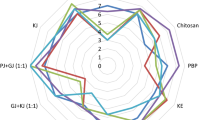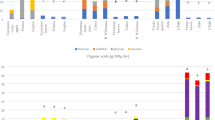Abstract
Antioxidants are compounds responsible for free radical scavenging in the body. They protect the organism from oxidative modification of cells and tissues. These modifications have been associated with degenerative diseases, atherosclerosis and carcinogenesis. Punica granatum displays high antioxidant potential due to the presence of phenolic compounds, which are capable of disease prevention. The present study showed the highest antioxidant activity in pomegranate peel than in seeds and pulp. Based on these results, pomegranate peel was used to produce dried extract that was added to commercial tomato juice and orange juice with strawberries. Analysis to determine the content of phenolic compounds and antioxidant activity was performed on pomegranate pulp, seeds and peel and in juices enriched with dried extract of pomegranate peel. The dried extract was responsible for a significant increase in antioxidant activity of the juices, proportional to the concentrations added. However, although both flavors of enriched juices displayed high antioxidant levels, the samples with higher dried extract concentrations received the lowest scores from sensory analysis participants due to the characteristic astringent flavor of pomegranate peels. Therefore, to obtain greater acceptance in the consumer market, we concluded that the maximum addition of dried pomegranate peel extract is 0.5% in tomato juice and orange juice with strawberries.
Similar content being viewed by others
References
Sies H, Stahl W (1995) Vitamins E and C, beta-carotene, and other carotenoids as antioxidants. Am J Clin Nutr 62(6 Suppl):1315S–1321S
Kryston TB, Georgiev AB, Pissis P, Georgakilas AG (2011) Role of oxidative stress and DNA damage in human carcinogenesis. Mutat Res 711(1–2):193–201
Stachowicz-Stencel T, Synakiewicz A, Owczarzak A, Aleksandrowicz-Wrona E, Sliwinska A, Lysiak-Szydlowska W, Balcerska A (2011) The antioxidant status and response to therapy in children with soft tissue sarcomas and neuroblastoma. Pediatr Blood Cancer 57(4):561–568
Dai Z, Nair V, Khan M, Ciolino HP (2010) Pomegranate extract inhibits the proliferation and viability of MMTV-Wnt-1 mouse mammary cancer stem cells in vitro. Oncol Rep 24(4):1087–1091
Mirmiran P, Mohammad RF, Golaleh A, Abbas S, Fereidoun A (2010) Effect of pomegranate seed on hyperlipidaemic subjects: A double-blind placebo-controlled clinical trial. Br J Nutr 104(3):402–406
Caligiani A, Bonzanini F, Palla G, Cirlini M, Bruni R (2010) Characterization of a potential nutraceutical ingredient: Pomegranate (Punica granatum L.) seed oil unsaponifiable fraction. Plant Foods Hum Nutr 6(3):277–283
Sashi GK, Dobroslawa B, Muntha KR, Guoyi M, Shabana IK, Daneel F (2010) Colon cancer chemopreventive activities of pomegranate ellagitannins and urolithins. J Agric Food Chem 58(4):2180–2187
Singh RP, Murthy KNC, Jayaprakasha GK (2002) Studies on the antioxidant activity of pomegranate (Punica granatum) peel and seed extracts using in vitro models. J Agric Food Chem 50(1):81–86
Hayouni EA, Miled K, Boubaker S, Bellasfar Z, Abedrabba M, Iwaski H, Oku H, Matsui T, Limam F, Hamdi M (2011) Hydroalcoholic extract based-ointment from Punica granatum L. peels with enhanced in vivo healing potential on dermal wounds. Phytomedicine 18(11):976–984
de Nigris F, Williams-Ignarro S, Botti C, Sica V, Ignarro LJ, Napoli C (2006) Pomegranate juice reduces oxidized low-density lipoprotein downregulation of endothelial nitric oxide synthase in human coronary endothelial cells. Nitric Oxide 15(3):259–263
Nair V, Dai Z, Khan M, Ciolino HP (2011) Pomegranate extract induces cell cycle arrest and alters cellular phenotype of human pancreatic cancer cells. Anticancer Res 31(9):2699–2704
Wang L, Alcon A, Yuan H, Ho J, Li QJ, Martins-Green M (2011) Cellular and molecular mechanisms of pomegranate juice-induced anti-metastatic effect on prostate cancer cells. Integr Biol (Camb) 3(7):742–754
Bachoual R, Talmoudi W, Boussetta T, Braut F, El-Benna J (2011) An aqueous pomegranate peel extract inhibits neutrophil myeloperoxidase in vitro and attenuates lung inflammation in mice. Food Chem Toxicol 49(6):1224–1228
Brand-Williams W, Cuvelier ME, Berset C (1995) Use of a free radical method to evaluate antioxidant activity. Food Sci Technol 28(1):25–30
Ding Hsiou-Yu (2011) Extracts and Constituents of Rubus chingii with 1,1-diphenyl-2-picrylhydrazyl (DPPH) free radical scavenging activity. Int J Mol Sci 12(6):3941–3949
Osman AM (2011) Multiple pathways of the reaction of 2,2-diphenyl-1-picrylhydrazyl radical (DPPH()) with (+)-catechin: Evidence for the formation of a covalent adduct between DPPH() and the oxidized form of the polyphenol. Biochem Biophys Res Commun 412(3):473–478
Swain T, Hillis WE (1959) The phenolic constituents of Prunus domestica I- The quantitative analysis of phenolic constituents. J Sci Food Agric 10(1):63–68
Sadek ES, Makris DP, Kefalas P (2009) Polyphenolic composition and antioxidant characteristics of kumquat (Fortunella margarita) peel fractions. Plant Foods Hum Nutr 64(4):297–302
Xia EQ, Deng GF, Guo YJ, Li HB (2010) Biological activities of polyphenols from grapes. Int J Mol Sci 11(2):622–646
Oliveira AC, Valentim IB, Silva CA, Bechara EJH, Barros MP, Mano CM, Goulartl MO (2009) Total phenolic content and free radical scavenging activities of methanolic extract powders of tropical fruit residues. Food Chem 115(2):469–475
Elfalleh W, Nasri N, Marzougui N, Thabti I, M’rabet A, Yahya Y, Lachiheb B, Guasmi F, Ferchichi A (2009) Physico-chemical properties and DPPH-ABTS scavenging activity of some local pomegranate (Punica granatum) ecotypes. Int J Food Sci Nutr 60(2):197–210
Cadot Y, Chevalier M, Barbeau G (2011) Evolution of the localisation and composition of phenolics in grape skin between veraison and maturity in relation to water availability and some climatic conditions. J Sci Food Agric 91(11):1963–1976
Mousavinejad G, Emam-Djomeh Z, Rezaei K, Hossein M, Khodaparast H (2009) Identification and quantification of phenolic compounds and their effects on antioxidant activity in pomegranate juices of eight iranian cultivars. Food Chem 115(4):1274–1278
Rodríguez H, Curiel JÁ, Landete JM, Rivas B, Felipe FL, Gómez-Cordovés C, Mancheño JM, Muñoz R (2009) Food phenolics and lactic acid bacteria. Int J Food Microbiol 132(2–3):79–90
Duthie SJ (2007) Berry phytochemicals, genomic stability and cancer: Evidence for chemoprotection at several stages in the carcinogenic process. Mol Nutr Food Res 51(6):665–674
Letenneur L, Proust-Lima C, Le Gouge A, Dartigues J, Barberger-Gateau P (2007) Flavonoid intake and cognitive decline over a 10-year period. Am J Epidemiol 165(12):1364–1371
Aviram M, Volkova N, Coleman R, Dreher M, Mk R, Ferreira D, Rosenblat M (2008) Pomegranate phenolics from the peels, arils, and flowers are antiatherogenic: Studies in vivo in atherosclerotic apolipoprotein E-deficient (E0) mice and in vitro in cultured macrophages and lipoproteins. J Agric Food Chem 56(3):1148–1157
Hülya Orak HA (2009) Evaluation of antioxidant activity, colour and some nutritional characteristics of pomegranate (Punica granatum L) juice and its sour concentrate processed by conventional evaporation. Int J Food Sci Nutr 60(1):1–11
Tzulker R, Glazer I, Bar-Ilan I, Hallando D, Aviram M, Amir R (2007) Antioxidant activity, polyphenol content, and related compounds in different fruit juices and homogenates prepared from 29 different pomegranate accessions. J Agric Food Chem 55(23):9559–9570
Kim ND, Mehta R, Yu WP (2002) Chemopreventive and adjuvant therapeutic potential of pomegranate (Punica granatum) for human breast cancer. Breast Cancer Res Treat 71(3):203–217
Lansky E, Newman R (2007) Punica granatum (pomegranate) and its potential for prevention and treatment of inflammation and cancer. J Ethnopharmacol 109(2):177–206
Kahya V, Meric A, Yazici M, Yuksel M, Midi A, Gedikli O (2011) Antioxidant effect of pomegranate extract in reducing acute inflammation due to myringotomy. J Laryngol Otol 125(4):370–375
Di Mascio P, Kaiser S, Sies S (1989) Lycopene as the most efficiente biological carotenoid singlet oxygen quencher. Arch Biochem Biophys 274(2):532–538
Shi J, Maguer M (2000) Lycopene in tomatoes: Chemical and physical properties affect by food processing. Crit Rev Biotechnol 20(4):293–334
Proteggente AR, Pannala AS, Paganga G, Van Buren L, Wagner E, Wiseman S, Van De Put F, Dacombe C, Rice-Evans CA (2002) The antioxidant activity of regularly consumed fruit and vegetables reflects their phenolic and vitamin C composition. Free Radic Res 36(2):217–233
Szeto YT, Tomlinson B, Benzie IF (2002) Total antioxidant and ascorbic acid content of fresh fruits and vegetables: Implications for dietary planning and food preservation. Br J Nutr 87(1):55–59
Aiyer HS, Kichambare S, Gupta RC (2008) Prevention of oxidative DNA damage by bioactive berry components. Nutr Cancer 60(Suppl 1):36–42
Zhang Y, Seeram NP, Lee R, Feng L, Heber D (2008) Isolation and identification of strawberry phenolics with antioxidant and human cancer cell antiproliferative properties. J Agric Food Chem 56(3):670–675
Acknowledgements
We greatly appreciate the Research Support Foundation of São Paulo (FAPESP) for funding the scholarship necessary for scientific initiation, which allowed for completion of this research.
Author information
Authors and Affiliations
Corresponding author
Rights and permissions
About this article
Cite this article
Mastrodi Salgado, J., Baroni Ferreira, T.R., de Oliveira Biazotto, F. et al. Increased Antioxidant Content in Juice Enriched with Dried Extract of Pomegranate (Punica granatum) Peel. Plant Foods Hum Nutr 67, 39–43 (2012). https://doi.org/10.1007/s11130-011-0264-y
Published:
Issue Date:
DOI: https://doi.org/10.1007/s11130-011-0264-y




